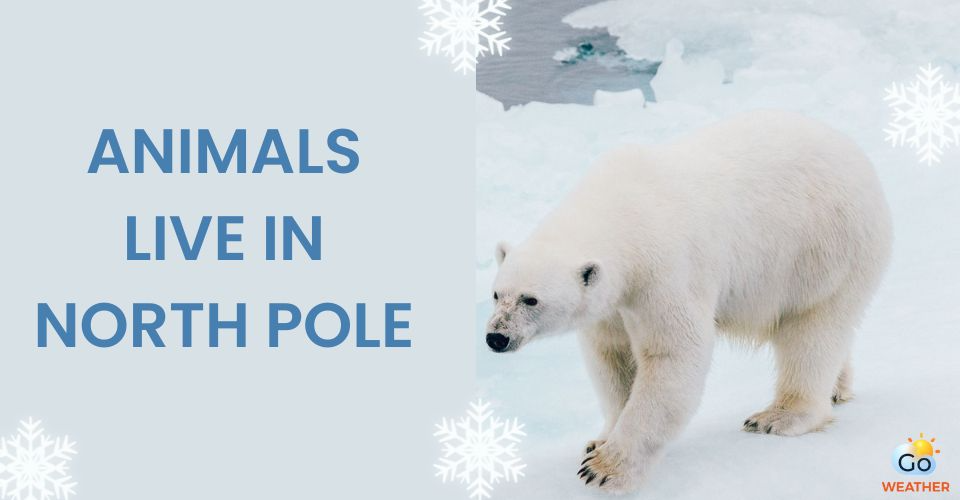What is the Weather in North Pole & the Climate in the Arctic?
Located in the southernmost and northernmost points on Earth, the weather in the South Pole (Antarctica) and the North Pole (Arctic) is very cold. Have you ever wondered which pole has colder weather? Is the South Pole warmer than the North Pole? If that's the case, you should check out this article, "What is the weather in North Pole & conditions in the Arctic?" Then you'll know the answer yourself.
.jpg)
What is the weather like in the North Pole?
The North Pole and Its Location
The Geographic North Pole is the northernmost point on Earth, where the planet's axis intersects with its surface. Its latitude is 90 degrees north.
All longitudinal lines begin from there, and from the North Pole, every direction is south. The North Pole has no time zone.
The Arctic Ocean surrounds the Pole, with water 3,400 feet deep and usually covered with 6 to 10 feet-thick drifting ice.
About 434 light-years above the North Pole lies the "North Star" - the POLARIS. During the night, Polaris does not set or rise at all. The star remains almost the same spot above the northern axis all year round while other stars circle it.
Polaris has been a vital marker for navigation for many centuries.
.jpg)
The Geographic North Pole is the northernmost point on Earth
Over time, the North Pole's location changes slightly. Since Earth's axis has a slight wobble, and as the pole intersects with Earth's axis, it also wobbles. According to scientists, the pole wobbles around 30 feet over 7 years.
What is the Weather in North Pole and Arctic Climate?
Though the North Pole is not as cold as the South Pole, it is well-known for its freezing weather. Cold and colder are the only two options there.
Weather in the North Pole
The North Pole (in the Arctic) has only two seasons: winter and summer. There is no spring or autumn. Winter lasts about 9 months yearly, while summer fills in the other 3 months.
Due to Earth's tilted axis, the northernmost point experiences only one sunrise at the March equinox and one sunset at the September equinox. During the summer, there's sunlight all day; and during the winter, it's always dark the whole day.
.jpg)
The North Pole just has two seasons, winter and summer
According to livescience.com, the average temperatures in the Geographic North Pole are a frosty -40°F during winters and a still chilly 32°F in summers, just at the freezing point.
But as mentioned previously, the South Pole (in the Antarctic) is much colder, with summer average temperatures at -18°F and winters at -76°F.
Why are the poles always so cold? The North Pole and the South Pole don't get any direct sun, even in the middle of July, when it is light all day in the northernmost point of Earth.
.jpg)
Some plants grow in the Arctic
But surprisingly, there are a bunch of plants growing here. Check out this article, “What plants grow in the North Pole?” to learn the flora types that are growing there!
2 Types of Climate in the Arctic (the North Pole Region)
Scientists divide Arctic climate into 2 significant types: maritime and continental climates.
The maritime climate prevails in areas near the ocean, such as Iceland, Alaska, or northern Russia. Winters in these coastal areas are wet and stormy, with snow and rainfall reaching 24 to 49 inches yearly.
Summers there tend to be cool and cloudy; the mean temperatures hover about 50°F.
.jpg)
Scientists divide the Arctic into two major types of climate
About the Arctic's continental climate, it takes place in the interior areas of the Arctic lands. The weather is dryer, with less precipitation (snow) in the winter and sunny summer days.
The weather in winter can be severe, with bitterly cold temperatures. In some areas of Siberia, average temperatures in January are below -40°F. During summer, the long days of sunshine can bring temperatures above 50 degrees Fahrenheit.
.jpg)
Climate in the Arctic
Despite being that cold, some animals are still found in the North Pole, such as polar bears, walruses, bowhead whales, etc. Read more in our guide: "What kind of animals live in the North Pole?”
Conclusion
These are some basic things about not only the weather in the geographical North Pole but also the climate in the Arctic. Did you find these facts interesting? That’s all for today’s article, “What is the weather in North Pole?” Hope you enjoyed it!









0 Comments
Leave a Comment
Your email address will not be published. Required fields are marked *